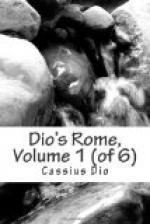[Sidenote: B.C. 250 (a.u. 504)] They voted that the consuls, Atilius Gaius, brother of Regulus, and Lucius Manlius, should make a campaign into Libya. On coming to Sicily they attacked Lilybaeum and undertook to fill up a portion of the ditch to facilitate bringing up the engines. The Carthaginians dug below the mound and undermined it. As they found this to be a losing game because of the numbers of the opposing workmen, they built another wall, crescent-shaped, inside. The Romans ran tunnels under the circle, in order that when the wall settled they might rush in through the breach thus made. The Carthaginians then built counter-tunnels and came upon many workers who were unaware of what the other side was doing. These they killed, and also destroyed many by hurling blazing firewood into the diggings. Some of the allies now, burdened by the strain of the siege and displeased because their superiors did not come down with their full wages, made propositions to the Romans to betray the place. Hamilcar discovered their plot but did not disclose it, for fear of driving them into open hostility. However, he supplied their leaders with money and in addition promised other supplies of it to the mass of them. In this way he won their favor, and they did not even deny their treachery but drove away the last envoys who returned. The latter then deserted to the consuls and received from them land in Sicily and other gifts.
The Carthaginians at home, hearing this, sent Adherbal with a very large number of ships carrying grain and money to Lilybaeum. The leader waited for a time of storm and sailed in. Thereupon many others likewise ventured to attempt a landing, and some made it, others were destroyed.
As long as both the consuls were present, the conflicts were even. Pestilence and famine, however, came to harass them and these caused one of them with the soldiers of his division to return home. Hamilcar then took courage and made sorties in which he would set fire to the engines and slay the men defending them; his cavalry, starting from Drepanum, prevented the Romans from getting provisions and overran the territory of their allies; and Adherbal ravaged the shores now of Sicily, now of Italy, so that the Romans fell into perplexity. [Sidenote: B.C. 249 (a.u. 505)] Meantime, however, Lucius Junius was making ready a fleet, and Claudius Pulcher made haste to reach Lilybaeum, where he manned ships of war. With these he overhauled Hanno the Carthaginian as he was leaving harbor on a five-banked ship. The prize craft served the Romans as a model in shipbuilding.
The interests of their fleet were so frequently endangered that the Romans were disheartened by the constant destruction of their ships. In these they lost numbers of men and vast sums of money. Yet they would not give up; nay, they even executed a man who in the senate opened his mouth about reconciliation with the Carthaginians, and they voted that a dictator should be named. Collatinus[26] was therefore named dictator and Metellus became master of the horse, but they accomplished nothing worthy of remembrance. While Collatinus[27] was being named dictator, Junius had won over Eryx, and Carthalo had occupied AEgithallus and taken Junius alive.




